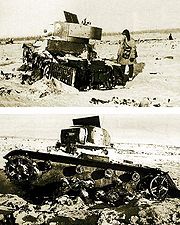
Teletank
Encyclopedia

Tank
A tank is a tracked, armoured fighting vehicle designed for front-line combat which combines operational mobility, tactical offensive, and defensive capabilities...
s produced in the Soviet Union in the 1930s and early 1940s. They saw their first combat use in the Winter war
Winter War
The Winter War was a military conflict between the Soviet Union and Finland. It began with a Soviet offensive on 30 November 1939 – three months after the start of World War II and the Soviet invasion of Poland – and ended on 13 March 1940 with the Moscow Peace Treaty...
, at the start of World War II
World War II
World War II, or the Second World War , was a global conflict lasting from 1939 to 1945, involving most of the world's nations—including all of the great powers—eventually forming two opposing military alliances: the Allies and the Axis...
. A teletank is controlled by radio from a control tank at a distance of 500–1,500 meters, the two constituting a telemechanical group. Teletanks were used by the Soviet Red Army
Red Army
The Workers' and Peasants' Red Army started out as the Soviet Union's revolutionary communist combat groups during the Russian Civil War of 1918-1922. It grew into the national army of the Soviet Union. By the 1930s the Red Army was among the largest armies in history.The "Red Army" name refers to...
in the Winter War, fielding at least two teletank battalions at the beginning of the Great Patriotic War.
Teletanks were equipped with DT machine gun
Degtyarev light machine gun
The Пулемёт Дегтярёвa Пехотный or DP was a light machine gun firing the 7.62x54mmR cartridge that was used by the Soviet Union starting in 1928. It was cheap and easy to manufacture - early models had fewer than 80 parts and could be built by unskilled labour. The DP was especially able to...
s, flamethrower
Flamethrower
A flamethrower is a mechanical device designed to project a long controllable stream of fire.Some flamethrowers project a stream of ignited flammable liquid; some project a long gas flame. Most military flamethrowers use liquids, but commercial flamethrowers tend to use high-pressure propane and...
s, smoke canisters, and sometimes a special 200–700 kg time bomb in an armored box, dropped by the tank near the enemy's fortifications and used to destroy bunkers up to four levels below ground. Teletanks were also designed to be capable of using chemical weapons, although they were not used in combat. Each teletank, depending on its model, was able to recognize sixteen to twenty-four different commands sent via radio on two possible frequencies to avoid interference and jamming. Teletanks were built based on T-18
T-18 tank
The T-18 light tank was the first Soviet-designed tank. Produced from 1928–31, it was based on the Renault FT-17, with the addition of a vertically sprung suspension....
, T-26
T-26
The T-26 tank was a Soviet light infantry tank used during many conflicts of the 1930s as well as during World War II. It was a development of the British Vickers 6-Ton tank and is widely considered one of the most successful tank designs of the 1930s....
, T-38, BT-5 and BT-7 tanks.
Standard tactics were for the control tank (with radio transmitter and operator) to stay back as far as practicable while the teletank (TT) approached the enemy. The control tank would provide fire support as well as protection for the radio control operator. If the enemy was successful at seizing the teletank, the control tank crew was instructed to destroy it with its main gun. When not in combat the teletank was driven manually.
In addition to teletanks, there were also remotely controlled telecutters and teleplanes in the Red Army.

